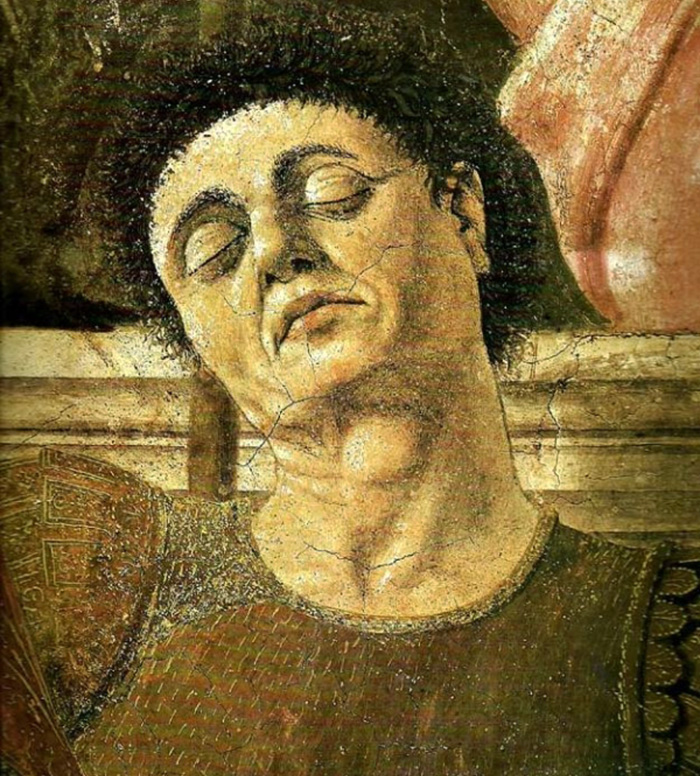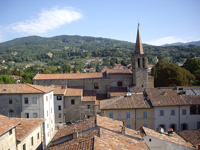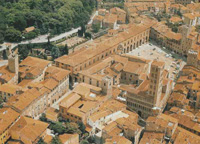| |
|
THE BEST PICTURE ALDOUS HUXLEY (1925) BORGO SAN SEPOLCRO IS NOT VERY EASY TO GET AT.
|
There is a small lowcomedy railway across the hills from Arezzo. Or you can approach it up the Tiber valley from Perugia. Or, if you happen to be at Urbino, there is a motor 'bus which takes you to San Sepolcro, up and down through the Apennines, in something over seven hours. No joke, that journey, as I know by experience. But it is worth doing, though preferably in some other vehicle than the 'bus, for the sake of the Bocca Trabaria, that most beautiful of Apennine passes, between the Tiber valley and the upper valley of the Metauro. It was in the early spring that we crossed it. Our omnibus groaned and rattled slowly up a bleak northern slope, among bald rocks, withered grass and still unbudded trees, it crossed the col and suddenly, as though by a miracle, the ground was yellow with innumerable primroses, each flower a little emblem of the sun that had called it into being.
And when at last one has arrived at San Sepolcro, what is there to be seen? A little town surrounded by walls, set in a broad flat valley between hills; some fine Renaissance palaces with pretty balconies of wrought iron; a not very interesting church, and finally, the best picture in the world.
The best picture in the world is painted in fresco on the wall of a room in the town hall. Some unwittingly beneficent vandal had it covered, some time after it was painted, with a thick layer of plaster, under which it lay hidden for a century or two, to be revealed at last in a state of preservation remarkably perfect for a fresco of its date. Thanks to the vandals, the visitor who now enters the Palazzo dei Conservatori at Borgo San Sepolcro finds the stupendous Resurrection almost as Piero della Francesca left it. Its clear, yet subtly sober colours shine out from the wall with scarcely impaired freshness. Damp has blotted out nothing of the design, nor dirt obscured it. We need no imagination to help us figure forth its beauty; it stands there before us in entire and actual splendour, the greatest picture in the world.
The greatest picture in the world…. You smile. The expression is ludicrous, of course. Nothing is more futile than the occupation of those connoisseurs who spend their time compiling first and second elevens of the world's best painters, eights and fours of musicians, fifteens of poets, all-star troupes of architects and so on. Nothing is so futile because there are a great many kinds of merit and an infinite variety of human beings. Is Fra Angelico a better artist than Rubens? Such questions, you insist, are meaningless. It is all a matter of personal taste. And up to a point this is true. But there does exist, none the less, an absolute - 2 - standard of artistic merit. And it is a standard which is in the last resort a moral one. Whether a work of art is good or bad depends entirely on the quality of the character which expresses itself in the work. Not that all virtuous men are good artists, nor all artists conventionally virtuous. Longfellow was a bad poet, while Beethoven's dealings with his publishers were frankly dishonourable. But one can be dishonourable towards one's publishers and yet preserve the kind of virtue that is necessary to a good artist. That virtue is the virtue of integrity, of honesty towards oneself. Bad art is of two sorts: that which is merely dull, stupid and incompetent, the negatively bad; and the positively bad, which is a lie and a sham. Very often the lie is so well told that almost every one is taken in by it - for a time. In the end, however, lies are always found out. Fashion changes, the public learns to look with a different focus and, where a little while ago it saw an admirable work which actually moved its emotions, it now sees a sham. In the history of the arts we find innumerable shams of this kind, once taken as genuine, now seen to be false. The very names of most of them are now forgotten. Still, a dim rumour that Ossian once was read, that Bulwer was thought a great novelist and “Festus” Bailey a mighty poet still faintly reverberates. Their counterparts are busily earning praise and money at the present day. I often wonder if I am one of them. It is impossible to know. For one can be an artistic swindler without meaning to cheat and in the teeth of the most ardent desire to be honest.
Sometimes the charlatan is also a first-rate man of genius and then you have such strange artists as Wagner and Bernini, who can turn what is false and theatrical into something almost sublime.
That it is difficult to tell the genuine from the sham is proved by the fact that enormous numbers of people have made mistakes and continue to make them. Genuineness, as I have said, always triumphs in the long run. But at any given moment the majority of people, if they do not actually prefer the sham to the real, at least like it as much, paying an indiscriminate homage to both.
And now. after this little digression we can return to San Sepolcro and the greatest picture in the world. Great it is, absolutely great, because the man who painted it was genuinely noble as well as talented. And to me personally the most moving of pictures, because its author possessed almost more than any other painter those qualities of character which I most admire and because his purely aesthetic preoccupations are of a kind which I am by nature best fitted to understand. A natural, spontaneous and unpretentious grandeur - this is the leading quality of all Piero's work. He is majestic without being at all strained, theatrical or hysterical – as Handel is majestic, not as Wagner. He achieves grandeur naturally with every gesture he makes, never consciously strains after it. Like Alberti, with whose architecture, as I hope to show, his painting has - 3 - certain affinities, Piero seems to have been inspired by what I may call the religion of Plutarch's Lives - which is not Christianity, but a worship of what is admirable in man. Even his technically religious pictures are paeans in praise of human dignity. And he is everywhere intellectual.
With the drama of life and religion he is very little concerned. His battle pictures at Arezzo are not dramatic compositions in spite of the many dramatic incidents they contain. All the turmoil, all the emotions of the scenes have been digested by the mind into a grave intellectual whole. It is as though Bach had written the 1812 Overture. Nor are the two superb pictures in the National Gallery - the Nativity and the Baptism - distinguished for any particular sympathy with the religious or emotional significance of the events portrayed. In the extraordinary Flagellation at Urbino, the nominal subject of the picture recedes into the background on the left-hand side of the panel, where it serves to balance the three mysterious figures standing aloof in the right foreground. We seem to have nothing here but an experiment in composition, but an experiment so strange and so startingly successful that we do not regret the absence of dramatic significance and are entirely satisfied. The Resurrection at San Sepolcro is more dramatic. Piero has made the simple triangular composition symbolic of the subject. The base of the triangle is formed by the sepulchre; and the soldiers sleeping round it are made to indicate by their position the upward jet of the two sides, which meet at the apex in the face of the risen Christ, who is standing, a banner in his right hand, his left foot already raised and planted on the brim of the sepulchre, preparing to set out into the world. No geometrical arrangement could have been more simple or more apt. But the being who rises before our eyes from the tomb is more like a Plutarchian hero than the Christ of conventional religion. The body is perfectly developed, like that of a Greek athlete, so formidably strong that the wound in its muscular flank seems somehow an irrelevance. The face is stern and pensive, the eyes cold. The whole figure is expressive of physical and intellectual power. It is the resurrection of the classical ideal, incredibly much grander and more beautiful than the classical reality, from the tomb where it had lain so many hundred years.
Aesthetically, Piero's work has this resemblance to Alberti's. that it too is essentially an affair of masses. What Alberti is to Brunelleschi, Piero della Francesca is to his contemporary, Botticelli. Botticelli was fundamentally a draughtsman, a maker of supple and resilient lines, thinking in terms of arabesques inscribed on the flat. Piero, on the contrary, has a passion for solidity as such. There is something in all his works that reminds one constantly of Egyptian sculpture. Piero has that Egyptian love of the smooth rounded surface that is the external symbol and expression of a mass. The faces of his personages look as though they were carved out of some very hard rock into - 4 - which it had been impossible to engrave the details of a human physiognomy - the hollows, the lines and wrinkles of real life. They are ideal, like the faces of Egyptian gods and princes, surface meeting and marrying with curved unbroken surface in an almost geometrical fashion. Look, for example, at the faces of the women in Piero's fresco at Arezzo: “The Queen of Sheba recognizing the Holy Tree.” They are all of one peculiar cast: the foreheads are high, rounded and smooth; the necks are like cylinders of polished ivory; from the midst of the concave sockets the eyelids swell out in one uninterrupted curve into convexity; the cheeks are unbrokenly smooth, and the subtle curvature of their surfaces is indicated by a very delicate chiaroscuro which suggests more powerfully the solidity and mass of the flesh than the most spectacular Caravaggioesque light and shade could do.
Piero's passion for solidity betrays itself no less strikingly in his handling of the dresses and drapery of his figures. It is noticeable, for example, that wherever the subject permits, he makes his personages appear in curious head-dresses that remind one by their solid geometrical qualities of those oddly shaped ceremonial hats or tiaras worn by the statues of Egyptian kings. Among the frescoes at Arezzo are several which illustrate this peculiarity. In that representing Herachus restoring the True Cross to Jerusalem, all the ecclesiastical dignitaries are wearing enormously high head-dresses, conical, trumpet-shaped, even rectangular. They are painted very smoothly with, it is obvious, a profound relish for their solidity. One or two similar head-dresses, with many varieties of wonderfully rounded helmets, are lovingly represented in the battle-pieces in the same place. The Duke of Urbino, in the well-known portrait at the Uffizi, is wearing a red cloth cap whose shape is somewhat like that of the "Brodrick" of the modern English soldier, but without the peak - a cylinder fitting round the head, topped by a projecting disk as the crown. Its smoothness and the roundness of its surfaces are emphasized in the picture. Nor does Piero neglect the veils of his female figures. Though transparent and of lawn, they hang round the heads of his women in stiff folds, as though they were made of steel. Among clothes he has a special fondness for pleated bodices and tunics. The bulge and recession of the pleated stuff fascinates him, and he likes to trace the way in which the fluted folds follow the curve of the body beneath. To drapery he gives, as we might expect, a particular weight and richness. Perhaps his most exquisite handling of drapery is to be seen in the altar-piece of the Madonna della Misericordia, which now hangs near the Resurrection in the town hall at San Sepolcro. The central figure in this picture, which is one of the earliest of Piero's extant works, represents the Virgin, standing, and stretching out her arms, so as to cover two groups of suppliants on either side with the folds of her heavy blue mantle. The mantle and the Virgin's dress hang in simple perpendicular folds, like the flutings on the robe of the - 5 - archaic bronze charioteer at the Louvre. Piero has painted these alternately convex and concave surfaces with a peculiar gusto.
It is not my intention to write a treatise on Piero della Francesca; that has been done sufficiently often and sufficiently badly to make it unnecessary for me to bury that consummate artist any deeper under layers of muddy comment. All I have meant to do in this place is to give the reasons why I like his works and my justifications for calling the Resurrection the greatest picture in the world. I am attracted to his character by his intellectual power: by his capacity for unaffectedly making the grand and noble gesture, by his pride in whatever is splendid in humanity. And in the artist I and peculiarly sympathetic the !over of solidity, the painter of smooth curving surfaces, the composer who builds with masses. For myself I prefer him to Botticelli, so much so indeed, that if it were necessary to sacrifice all Botticelli's works in order to save the Resurrection, the Nativity, the Madonna della Misericordia and the Arezzo frescoes, I should unhesitatingly commit the Primavera and all the rest of them to the flames. It is unfortunate for Piero's reputation that his works should be comparatively few and in most cases rather difficult of access. With the exception of the Nativity and Baptism at the National Gallery, all the really important works of Piero are at Arezzo, San Sepolcro and Urbino. The portraits of the Duke and Duchess of Urbino with their respective triumphs, in the Uffizi, are charming and exceedingly “amusing”; but they do not represent Piero at his best. The altarpiece at Perugia and the Madonna with saints and donor at Milan are neither of them first-rate. The St Jerome at Venice is goodish; so too is the damaged fresco of the Malatesta, at Rimini. The Louvre possesses nothing, and Germany can only boast of a study of architecture, inferior to that at Urbino. Anybody, therefore, who wants to know Piero must go from London to Arezzo, San Sepolcro and Urbino. Now Arezzo is a boring sort of town, and so ungrateful to its distinguished sons that there is no monument within its walls to the divine Aretino. I deplore Arezzo; but to Arezzo, nevertheless, you must go to see Piero's most considerable works. From Arezzo you must make your way to San Sepolcro, where the inn is only just tolerable, and to which the means of communication are so bad that, unless you come in your own car, you are fairly compelled to stay there. And from San Sepolcro you must travel by 'bus for seven hours across the Apennines to Urbino. Here, it is true, you have not only two admirable Pieros (the Flagelation and an architectural scene), but the most exquisite palace in Italy and very nearly a good hotel. Even on the most wearily reluctant tourist Urbino imposes itself; there is no escaping it; it must be seen. But in the case of Arezzo and San Sepolcro there is no such moral compulsion. Few tourists, in consequence, take the trouble to visit them.
If the principal works of Piero were to be seen in Florence, and those of Botticelli at San Sepolcro, I do not doubt that the public estimation of these - 6 - two masters would be reversed. Artistic English spinsters would stand in rapturous contemplation before the story of the True Cross, instead of before the Primavera. Raptures depend largely upon the stars in Baedeker, and the stars are more freely distributed to works of art in accessible towns than to those in the inaccessible. If the Arena chapel were in the mountains of Calabria, instead of at Padua, we should all have heard a good deal less of Giotto.
But enough. The shade of Conxolus rises up to remind me that I am running into the error of those who measure merit by a scale of oddness and rarity.
|
|
|
![]()

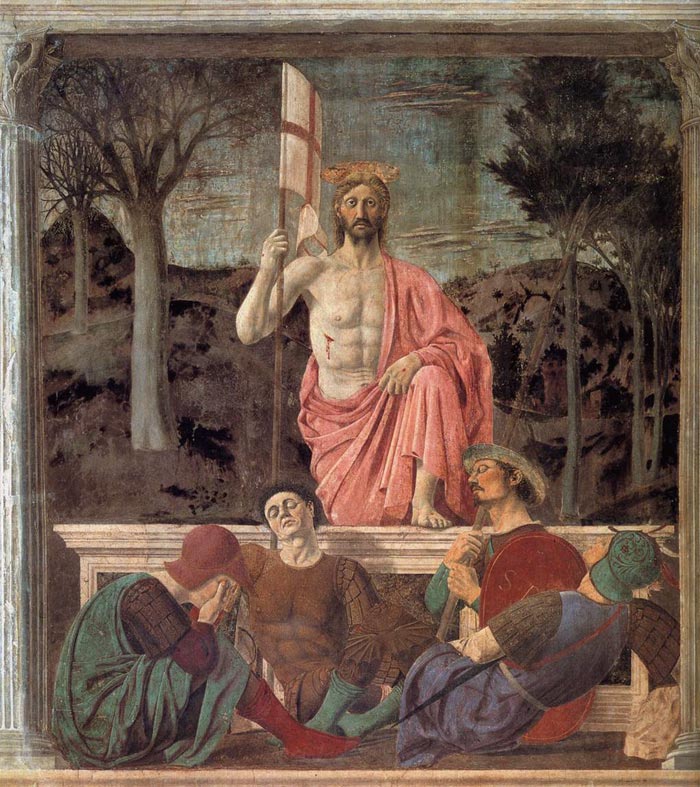
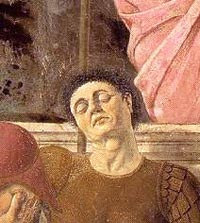 Piero della Francesca, The Resurrection (self-portrait, detail of fresco), Museo Civico of Sansepolcro
Piero della Francesca, The Resurrection (self-portrait, detail of fresco), Museo Civico of Sansepolcro 